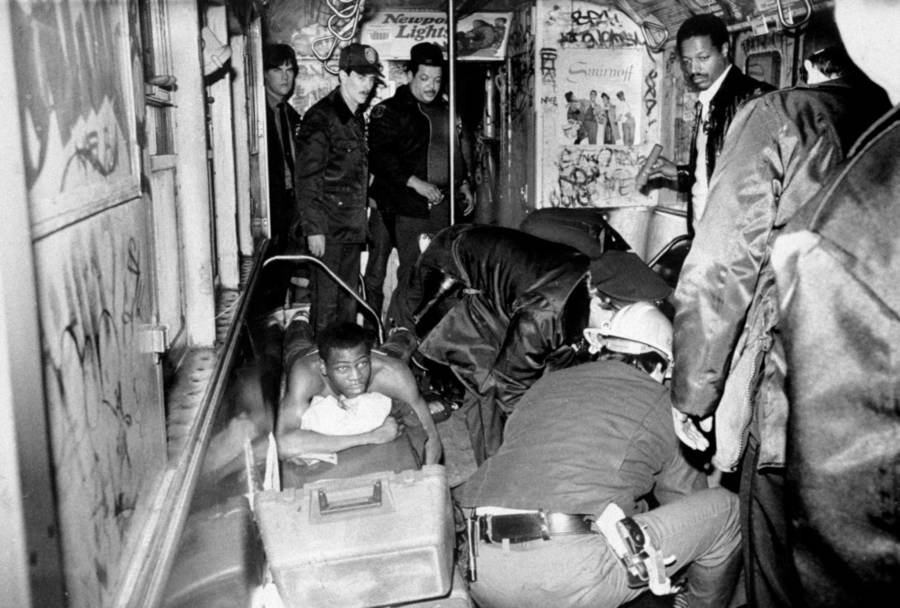Bernhard Goetz made history when he shot four black men who tried to rob him, and opened the door for a nationwide debate about race, crime, and how much power civilian vigilantes have.

Bettman/Getty Images
Subway gunman Bernhard Goetz arrives at court for the third day of his trial for attempted murder.
In the early afternoon on December 22, 1984, the seventh car on a ten-car 2 subway train headed downtown was bustling with people. A pair of women were seated on the bench by the door next to a man in a long jacket. A man in a blue jacket sat across from them, while the rest of the bench was taken up by a man laying down. Two other men sat at the end of the train, near the conductor’s cab.
Throughout several stops, the number of passengers fluctuated, but when the train left the 14th street station, about 15 or 20 passengers were in the car.
Suddenly, five of the men grouped together. There was a quick scuffle, and then in front of the train car, one man opened fire on four of the others.
The man was Bernhard Goetz, a man who made headlines when he defended himself against his would-be muggers in a subway car in New York City. His actions would spur a series of debates over race and crime, the limits of self-defense, and to what extent civilians could rely on the police for protection.
To understand Bernhard Goetz’s actions that day, one must go back several years before when he found himself being mugged for the first time.
In 1981, Goetz was attacked in the Canal Street subway station by three young men who he claimed were trying to rob him. They threw him through a plate glass door and onto the ground, permanently injuring his chest and knee. Despite his injuries, he was able to assist a police officer in arresting one of the men.
Unfortunately, the man was only charged with criminal mischief. Goetz was angered beyond belief, resentful of the fact that the others had gotten away, and the one who hadn’t barely received a slap on the wrist.
Driven by his anger, Goetz applied for a concealed carry permit. He argued that since he routinely carried valuable equipment and large sums of cash for his job, he was a target for robbery. His application was ultimately denied for insufficient need, but that didn’t stop him. A few months later, Bernhard Goetz purchased a 5-shot .38-caliber Smith & Wesson Bodyguard revolver while on a trip to Florida.
It was this unregistered gun that was used in the 1984 subway shooting.
According to Goetz, on the afternoon of December 22, he entered a full subway car as it was pulling out of the 14th subway station. He entered through the rear of the car and took a seat on one of the benches.
At that point, he says, four black men accosted him. The men in question were Barry Allen, Troy Canty, Darrel Cabey and James Ramseur, all teenagers from the Bronx, who had been on the train when he entered.

New York Daily News Archive/Getty ImagesThe aftermath of the Bernhard Goetz shooting, inside the graffiti-covered subway car.
The version of events differs between retellings and varies depending on who’s doing the retellings. Canty and Ramseur claimed they were panhandling and asked Goetz if he had five dollars, while Goetz claimed they cornered him and demanded money. Allen pled the Fifth Amendment when questioned about the circumstances.
After he refused to pay, Goetz opened fire, firing five shots at the men.
Again, the sequence of events changes depending on who’s recounting it, though each retelling ends with each of the men getting shot. Goetz claims that each man was shot once, and that one shot missed, while the teenagers claimed that each man was shot, but that Cabey was shot twice.
After the shooting, Bernhard Goetz fled. He’d been asked if he was a police officer and whether or not he had a permit for his revolver. When the conductor asked him to hand it over, Goetz jumped onto the tracks and ran through the subway tunnels to the Chambers Street station.
He went home momentarily, then rented a car and drove to Vermont. For several days he moved around New England, staying in motels and paying cash for things. In New York, he had been identified as a suspect, and a manhunt was underway. Eventually, he turned himself in, at a police station in Concord, New Hampshire, stating simply, “I am the person they are seeking in New York.”

Bettmann/Getty ImagesPolice escort Bernhard Goetz out of a New York courthouse after a hearing in his attempted murder trial.
Upon his arrest, Bernhard Goetz gave a two-hour videotaped interview with police. He described being mugged in the past and the events that lead to his surrender. He expressed wanting to shoot them again, and an insatiable need for revenge on those who had wronged him. The tapes were played for the jury during his trial. Despite him describing wanting to gouge out Canty’s eyes with his keys, he only served eight months in prison.
After his actions brought him celebrity status, he became somewhat of a national hero for vigilante justice. Bumper stickers with slogans like “Ride with Bernie – he Goetz ’em!” were all over New York, and people were praising him for taking a stand against the crime-ridden city.
Even more shocking than the support was the fact that, beginning in 1990, the crime rate in New York rapidly declined. One of the most dangerous cities in the country soon became one of the safest, and Goetz’s supporters couldn’t help but attribute it to their hero.
As of 2014, Bernhard Goetz still lives in the same Union Square apartment he lived in on that fateful December day and is still a supporter of vigilante justice, though he’s not as personally involved in enacting it as he once was.
He now spends his time nursing squirrels in a nearby cemetery and advocating for marijuana legalization.
After learning about Bernhard Goetz, the Subway Vigilante, check out these photos that show just how dangerous the New York City subways used to be. Then, read about the cold-blooded revenge of Buford Pusser.




